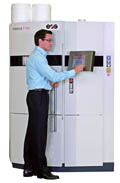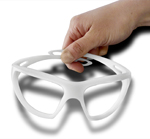10 October 2008
EOS to present latest generation of laser-sintering systems and powders
 The focus of attention on the EOS stand will be the new FORMIGA P 100 entry-level, laser-sintering machine for the production of plastic components. With turn-around times of less than 24 hours, the machine integrates itself perfectly into a continuous production environment that requires high flexibility at comparatively low investment cost.
The focus of attention on the EOS stand will be the new FORMIGA P 100 entry-level, laser-sintering machine for the production of plastic components. With turn-around times of less than 24 hours, the machine integrates itself perfectly into a continuous production environment that requires high flexibility at comparatively low investment cost.
The preparation and control of the building process is conveniently carried out at the user’s desk. Hence the FORMIGA P 100 lends itself to decentralised production. The machine is particularly easy to set up, use and maintain. With 50 FORMIGAs shipped since its launch, there is clear market acceptance for this machine, which can build parts with high surface quality and resolution.
New plastic materials
PrimePart DC is a new, impact resistant plastic material from EOS. The natural coloured polyamide offers an elongation at break of 50 percent. That is about twice as high as those of previously available materials.
With a tensile strength of 48 MPa and a Young’s modulus of 1,550 MPa, the other mechanical properties are comparable to those of the proven PA 2200. PrimePart DC is therefore especially impact resistant.
”We are seeing a lot of interest for automotive applications that require good impact behaviour, like interior parts”, stated Thomas Mattes, Vice President for plastic laser-sintering at EOS.
 A further new plastic is PrimePart ST, a flexible material that reaches an elongation at break of up to 250 percent. Parts laser-sintered from this material are fully dense, so gas-tight products can be produced directly and without requiring infiltration. PrimePart ST is the first flexible material in the world of layer manufacturing technologies that does not require post-infiltration. Potential applications are shoe soles, seals and hoses.
A further new plastic is PrimePart ST, a flexible material that reaches an elongation at break of up to 250 percent. Parts laser-sintered from this material are fully dense, so gas-tight products can be produced directly and without requiring infiltration. PrimePart ST is the first flexible material in the world of layer manufacturing technologies that does not require post-infiltration. Potential applications are shoe soles, seals and hoses.
Another new plastic powder is a black version of the proven EOS PA2200 material, which is white. PA 2202 black is a polyamide material containing black pigments. The resulting parts are coloured throughout their whole volume, which makes them resistant against scratches, abrasion and dirt.
The parts are thus well suited to mechanically stressed applications or dirty environments. The polymer in black will be the first choice for industries where this colour of components is relevant, such as in the automotive industry, especially under-bonnet parts.
New metal materials
Following on from the introduction of commercially pure EOS Titanium TiCP for use in a specialised version of the EOSINT M 270 laser-sintering machine, EOS has developed alloyed versions that are applicable to aerospace, motorsport and medical applications. EOS Titanium Ti64 (6% aluminium, 4% vanadium) combines light weight with corrosion resistance, high strength and good bioadhesion.
EOS has produced two versions of this alloy – standard and extra-low interstitial (Ti64 ELI), the latter having particularly low impurity, higher ductility and better fracture toughness. Both materials fulfil the requirements of their respective ASTM standards for wrought titanium and the parts are approximately 100 per cent dense. They are produced in a special argon atmosphere in the EOSINT M 270 Titanium Version.
 A further new metal powder available from EOS is a special purpose CoCrMo superalloy, called CobaltChrome SP2, developed especially for dental restorations including crowns and bridges. Key characteristics are high strength, corrosion resistance, biocompatibility and a thermal performance suited to veneering with dental ceramic. EOS offers several metal materials tuned to the needs of specific applications.
A further new metal powder available from EOS is a special purpose CoCrMo superalloy, called CobaltChrome SP2, developed especially for dental restorations including crowns and bridges. Key characteristics are high strength, corrosion resistance, biocompatibility and a thermal performance suited to veneering with dental ceramic. EOS offers several metal materials tuned to the needs of specific applications.
- Contact Information
- Name: Stuart Jackson
- Email: stuart.jackson@eos.info

